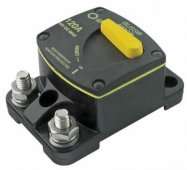wattmatters
Solar Wizard
I need some help choosing a suitable DC circuit breaker / over current protection.
I've searched on the forum and not really getting far with suitable suggestions.
This is my battery system schematic, feeding an all-in-one inverter:

By all means make suggestions on the above if it should be configured a different way. Not shown in the diagram are the AC input and output and the solar PV input.
The system's primary job is for grid outage backup. Not much cycling of these batteries is expected. Just when needed.
At present I have one of the battery banks supplying the all-in-one inverter and I have a 20A limit set on charging, which I plan to lift to 40A when the second bank is added. I have a 100A megafuse and one of those cheap circuit breakers like this:

But I'm not convinced this circuit breaker is really that good of a device so am looking for advice on suitable alternatives.
I don't think I need smart relay control, for now I'll trust the inverter's inbuilt low voltage / low charge state cut off protection. I think I just want a suitable over current protection device which can also be manually switched if I need.
The inverter is rated to supply up to max of 4kW continuous on the AC output side, so on the DC side I don't expect ever to draw more than about 80A and any such high load would be for brief periods, a couple of minutes perhaps. Most of the time during outage back up the load on the DC side will be in the 10-15A range, less if it's daytime and the off-grid solar PV array is also supplying power. Charging current will be limited to 40A max.
Also, being located in Australia suppliers in the USA are typically out of bounds (most don't ship or if they do the shipping prices are ridiculous).
I've searched online for 100A DC circuit breakers but the array of options presented are pretty confusing, many are clearly not DC breakers but as for the rest, well the price variances are huge and I'm having trouble knowing what is suitable and of suitable quality.
Suggestions?
Thanks in advance.
I've searched on the forum and not really getting far with suitable suggestions.
This is my battery system schematic, feeding an all-in-one inverter:

By all means make suggestions on the above if it should be configured a different way. Not shown in the diagram are the AC input and output and the solar PV input.
The system's primary job is for grid outage backup. Not much cycling of these batteries is expected. Just when needed.
At present I have one of the battery banks supplying the all-in-one inverter and I have a 20A limit set on charging, which I plan to lift to 40A when the second bank is added. I have a 100A megafuse and one of those cheap circuit breakers like this:

But I'm not convinced this circuit breaker is really that good of a device so am looking for advice on suitable alternatives.
I don't think I need smart relay control, for now I'll trust the inverter's inbuilt low voltage / low charge state cut off protection. I think I just want a suitable over current protection device which can also be manually switched if I need.
The inverter is rated to supply up to max of 4kW continuous on the AC output side, so on the DC side I don't expect ever to draw more than about 80A and any such high load would be for brief periods, a couple of minutes perhaps. Most of the time during outage back up the load on the DC side will be in the 10-15A range, less if it's daytime and the off-grid solar PV array is also supplying power. Charging current will be limited to 40A max.
Also, being located in Australia suppliers in the USA are typically out of bounds (most don't ship or if they do the shipping prices are ridiculous).
I've searched online for 100A DC circuit breakers but the array of options presented are pretty confusing, many are clearly not DC breakers but as for the rest, well the price variances are huge and I'm having trouble knowing what is suitable and of suitable quality.
Suggestions?
Thanks in advance.






